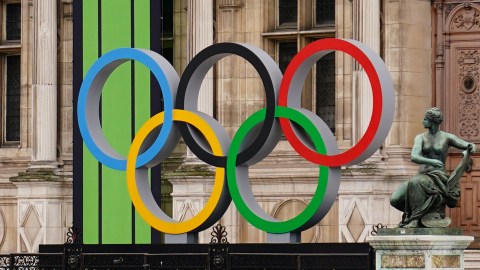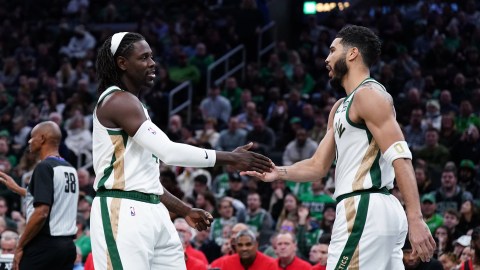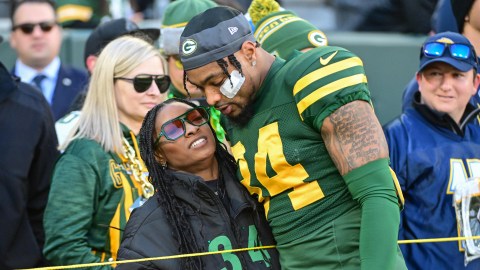Leading up to the Summer Olympics, the talk around the U.S. Women's Soccer team has been of gold.
London is the place where this team will avenge its FIFA World Cup loss to Japan from last summer. London is where Hope Solo will continue her rise in personal redemption as she continues to make her mark as the best goalkeeper in the game. London is where Alex Morgan will come into her own as the team's elite striker, taking the mantle Abby Wambach has been handing her even as Wambach shows she's still a force to be reckoned with on the international stage.
But Glasgow, Scotland, is where the U.S.'s path to the podium stand began Wednesday. Maybe that was the problem. Within 14 minutes, Solo had been stunned twice as France staked a 2-0 lead.
Suddenly, the mention of a dominating U.S. team marching toward a fulfilling gold seemed a bit out of place. Maybe other fears would be realized, and the U.S. would once again find that the rest of the world's soccer was passing it by as it fell again in a big moment.
But the hallmark of the U.S. team has never been across-the-board perfection. This is not an American squad that can say it has the edge in all facets of the game, or even that it knows how to play as a cohesive unit for 90 minutes.
One thing the U.S. team can do is rip off incredible stretches. Like its long-reaching corners and crosses, where the team scores on outrunning the competition and hitting blistering shots, this is a team that capitalizes on big moments. And Wednesday, down 2-0 with everyone who was watching wondering whether this indeed was the team that was supposed to take no prisoners on its way to the medal stand, the U.S. delivered another vintage performance in that regard.
Wambach started it, knocking in a header off a Megan Rapinoe corner (the Rapinoe-Wambach combination being not only a favorite way to score, but also the way this team will be remembered in World Cup history thanks to the epic equalizer in the 2011 quarterfinal). The goal came just after midfielder Shannon Boxx left the field with injury, and it was the perfect jolt to remind the U.S. that it had dominated the first 10 minutes of the game and should be taking care of the rest.
Morgan continued the run, gathering a high bounce from a Solo punt that missed Wambach's waiting head. Morgan finessed the ball around the defense with her left foot, punching it high into the goal in a move that served as a reminder of why she gets such accolades.
By halftime, it was a wonder how France had ever been in the game at all. The U.S. kept the attack strong in the second half, with Carli Lloyd rocketing in a shot from outside the box. Then Tobin Heath gathered an excellent pass from Rapinoe and charged the goal, with Morgan sending in the rebound for the final 4-2 margin.
The box matched the prediction: The U.S. would rule the game in every facet and win in the end, with Morgan and Wambach leading the way. But the team had to fight through a serious mess to get to that point.
Still, even if Wednesday's victory left the U.S. feeling shaky about its game, it was a fine reminder of what this team is all about. Other top teams may play better possession soccer and make more precise passes, but U.S. women's soccer has always been about huge moments — about great athletes running faster, jumping higher, sliding harder and kicking farther than their opponents. And as much as the Americans would like to shake that style and find a way to compete in the brand of soccer that the rest of the world promotes, their victory over France showed just why they shouldn't.
When the U.S. plays its game, it's unstoppable.
Unfortunately, one trademark of the U.S. game (talking about the men here, too) is how much the team struggles when starting games. Last year in the World Cup, the U.S. conceded far too many early goals. On Wednesday, that was again the case, as France caught the defense out of position and put the U.S. in a hole that — had France been able to replicate its pressure — would have likely been insurmountable.
Wambach said after the game, "Somehow, we always like to make things really dramatic for the fans, so you're welcome."
But, while the team would like to stay out of early deficits, the U.S. has also learned not to fear trailing. This is the team that came back against Brazil in the final minute, and the mental fortitude and character the players build with every one of these come-from-behind wins certainly helps the team's confidence moving forward.
Playing ahead can also have its drawbacks for this team, as the U.S. can look shaky with a lead. Brandi Chastain was beside herself near the end of Wednesday's win, going on about how she wished the U.S. would learn to play in the final minutes. The Americans were holding on against France, she said, but a lack of discipline in controlling the ball and learning how to maintain pressure despite not playing for goals late could be a serious hindrance to this team later in the tournament. (Don't forget that the U.S. led Japan twice in the World Cup final but failed to hold both leads.)
As dispiriting as it is to see the U.S. trail early, that may be part of the group's identity. This team has plenty of guts to fight out of tough situations but seemingly less ability when not being aggressive while playing ahead.
The strengths of the U.S. have often been a double-edged sword. The team is excellent on long passes and outrunning opponents, but without those opportunities, the offense can die. Wambach and Morgan are scintillating as scorers, but when they're marked they can struggle to make the open-space goals that make them so dangerous. (Morgan was a particular study in this on Wednesday. No longer the upstart who gets room against the defense, she got baited into a very physical game at some points, and she had to find a way to make room for herself.)
But this is also a team that's deep enough — and experienced enough in these big games — that an early scare like this may do wonders. The defense needs some serious help after its lapses against France, where just about the entire team would bunch in the box, only to see France get a goal out of it.
Pia Sundhage's coaching decisions on personnel and substitutions also warrant scrutiny, as the U.S. continues to try to find the balance of the speedy, attack-oriented game that fits its players with the possession-oriented game that more skilled teams will force on the U.S.
But in terms of overall game and spirit, the U.S. delivered the goods on Wednesday. Aside from the minutes when France came out of nowhere, the Americans were in control of most aspects of the game, with the picture-pretty goals and overall ball possession leading to success.
This U.S. team is a thrill to watch when it's on, because anything can happen — and that anything usually means goals for the U.S.
While concerns and questions will linger from a game that left many doubting the main storyline of this Olympics, nothing has really changed. The U.S. has great players. They want to win, and they're ready to win. They have their own style, even when the rest of the world is telling them that it may not work anymore.
Now the U.S. just has to go out, do its job and show that its way is good enough for gold.
Have a soccer question? Send it to us via Twitter at @NESNsoccer, NESN Soccer's Facebook page or send it here.



